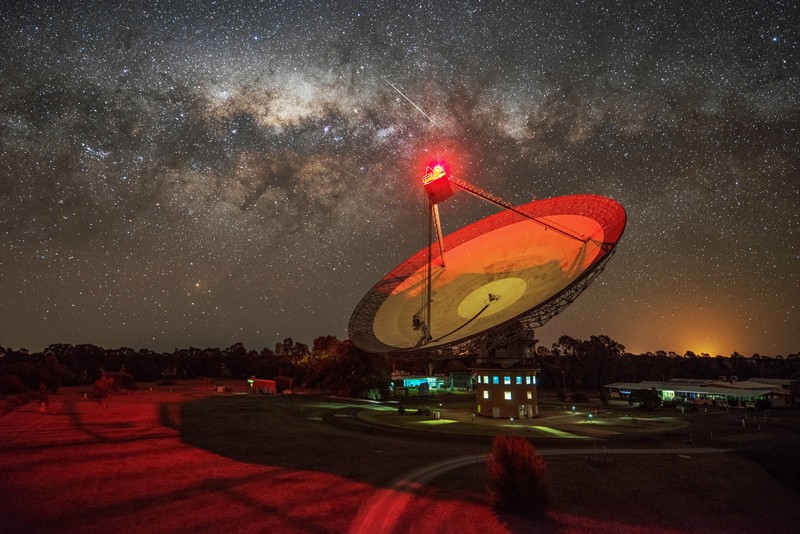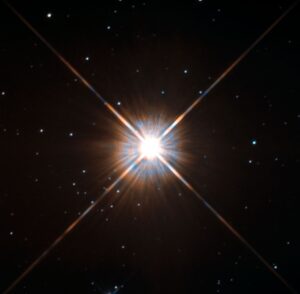The results are in from a study of a strange signal picked up last year by the Breakthrough Listen project. It turns out to be Earth-based interference from human technologies, not a signal from the Proxima Centauri system.
Breakthrough Listen is an astronomical science program searching for technosignatures—signs of technology that may have been developed by extraterrestrial intelligence. Listen’s science team uses some of the largest radio telescopes in the world, equipped with the most capable digital processing systems, to capture data across broad swaths of the radio spectrum in the direction of a wide range of celestial targets.
“It was really exciting to detect a candidate signal that passed all our filters. While BLC1 [this signal] is most likely human-generated interference, it has been an excellent test of our tools and detection pipeline,” said Dr Danny Price, Project Scientist for Breakthrough Listen in Australia, and Senior Research Fellow at the Curtin University node of the International Centre for Radio Astronomy Research (ICRAR).
The search is challenging because Earth is awash with radio signals from human technology—cell phones, radar, satellites, TV transmitters, and so on. Searching for a faint signal from a distant star is akin to picking out a needle in a vast, shifting, digital haystack.
“During the Breakthrough Listen search for intelligent life beyond Earth, we detected a signal-of-interest with the CSIRO Parkes ‘Murriyang’ radio telescope,” explained Dr Price.
“The signal appeared during observations toward our nearest stellar neighbour, Proxima Centauri, and had many characteristics expected for an artificial signal that travelled interstellar distances”

The 64-metre Parkes Murriyang telescope is one of the facilities involved in the search for extraterrestrial intelligence, or SETI. Credit: CSIRO/A. Cherney.
Two research papers, published in Nature Astronomy, discuss both the detection of the candidate signal and an advanced data analysis process that can finely discern “false positives”.
The Listen team scanned the area across a frequency range of 700 MHz to 4 GHz, with a resolution of 3.81 Hz—in other words, performing the equivalent of tuning to over 800 million radio channels at a time, with superb detection sensitivity.
Shane Smith, an undergraduate researcher working with Dr Price in the summer 2020 Breakthrough Listen internship program, ran the data from these observations through Breakthrough Listen’s search pipeline. He detected over 4 million “hits”—frequency ranges that had signs of radio emission. This is actually quite typical for Listen’s observations; the vast majority of these hits make up the haystack of emission from human technology.
As with all of Listen’s observations, the pipeline looks for signals a long way from Earth, as well as making sure they’re steadily changing over time (as they would if the transmitter was on a distant planet) and only detectable when the telescope is pointed in the source direction (rather than being detected whether or not the telescope was pointing towards that same distant planet).
Even after both of these data filters are applied, a handful of candidates remain that must be inspected visually. One such signal, BLC1, fit the bill.
“The signal passed our data quality checks and interference filters, so we started to refer to it as ‘BLC1’ internally, short for Breakthrough Listen Candidate #1. The name stuck,” said Dr Price.
“After very extensive analysis, we were able to determine that BLC1 is a very unusual form of interference that we hadn’t encountered in our data before.”
Dr Sofia Sheikh, currently a postdoctoral researcher with the Listen team at UC Berkeley, dug into a larger dataset of observations taken at other times. She found around 60 signals that share many characteristics of the candidate, but are also seen when the telescope is looking elsewhere.
“We can therefore confidently say that these other signals are local to the telescope and human-generated,” says Sheikh. “The signals are spaced at regular frequency intervals in the data, and these intervals appear to correspond to multiples of frequencies used by oscillators that are commonly used in various electronic devices.”
“Taken together, this evidence suggests that the signal is interference from human technology, although we were unable to identify its specific source. The original signal found by Shane Smith is not obviously detected when the telescope is pointed away from Proxima Centauri – but given a haystack of millions of signals, the most likely explanation is still that it is a transmission from human technology that happens to be ‘weird’ in just the right way to fool our filters.”
Dr Price remarked, “The detection of BLC1 shows that our detection pipelines are working and we have the tools to detect true signatures of intelligent life beyond Earth, if they exist. It’s been a pleasure working with Shane and Sofia, who are already outstanding this early on in their research careers.”
“We are currently in a golden age for astrobiology, and the technology we now possess allows for technosignature searches on scales that were previously impossible.”
“I’m particularly excited by SETI opportunities with the recently-upgraded Murchison Widefield Array (MWA), and the Square Kilometre Array (SKA) pathfinder telescopes, and I’m looking forward to starting new SETI projects in a collaboration between ICRAR and the international Breakthrough Listen team.”
PUBLICATION:
Preprints of the papers, links to the data and associated software, artwork, videos, and supplementary content may be accessed at http://seti.berkeley.edu/blc1
MORE INFO:
The Breakthrough Initiatives
The Breakthrough Initiatives are a suite of space science programs (Listen, Starshot and Watch) investigating the fundamental questions of life in the Universe.
In July 2015, together with Stephen Hawking, Yuri Milner announced the launch of the $100 million astronomical program Breakthrough Listen, to reinvigorate the search for extraterrestrial intelligence in the universe. In April 2016, they launched Breakthrough Starshot, a $100 million research and engineering program seeking to develop a new technology for uncrewed interstellar travel. Breakthrough Watch, launched in January 2016, is an astronomical program to develop Earth- and space-based technologies that can find evidence of primitive life on Earth-like planets in our cosmic neighbourhood. Additional information about Breakthrough Initiatives.
All of these philanthropic initiatives are funded by the Breakthrough Foundation established by Yuri and Julia Milner. Additional information about Yuri.
Breakthrough Listen is making all of the data from the Parkes scans available to the public to examine themselves. The team has also just published two papers outlining the details of the data acquisition and analysis, and a research note describing followup observations of Proxima Centauri conducted with the Parkes Telescope in April 2021. Listen will continue monitoring of Proxima Centauri, which remains a compelling target for technosignature searches, using a suite of telescopes around the world. And the team continues to refine algorithms to improve their ability to discriminate between “needles” and “hay”, including as part of a recently-completed crowdsourced data processing competition in collaboration with kaggle.com.
ICRAR
International Centre for Radio Astronomy Research (ICRAR) is a joint venture between Curtin University and The University of Western Australia with support and funding from the State Government of Western Australia.
